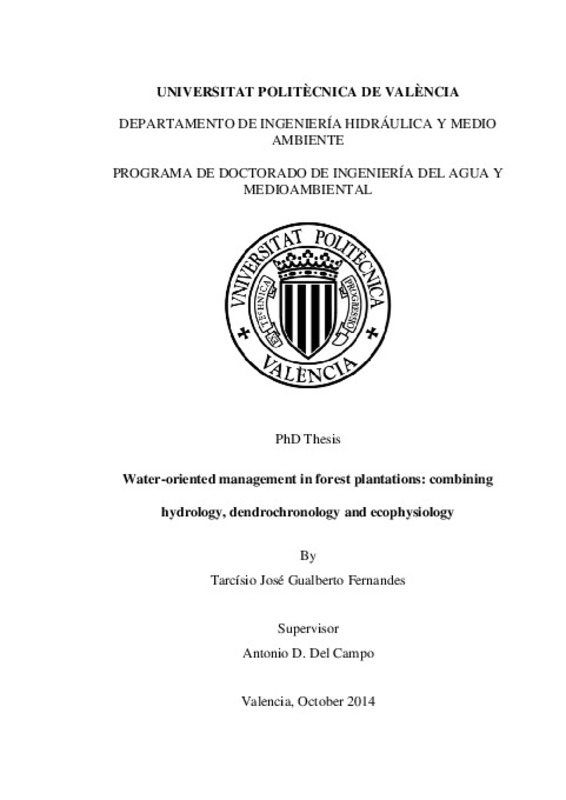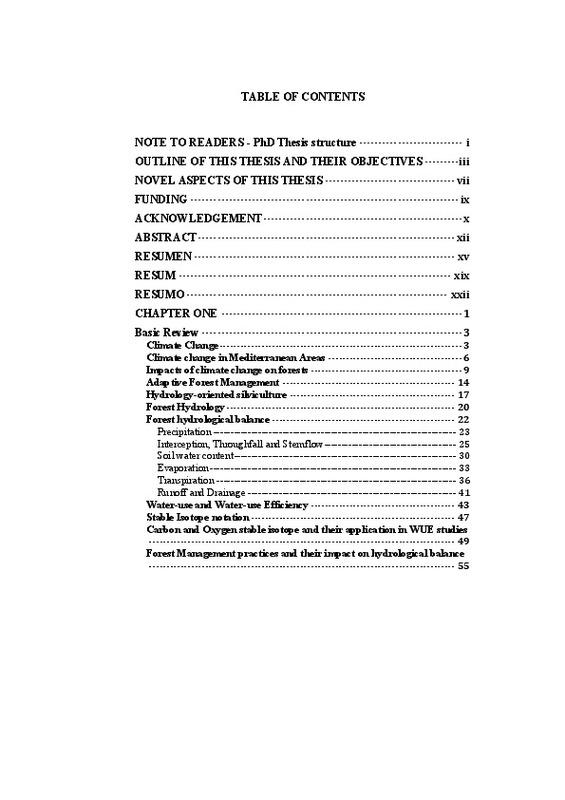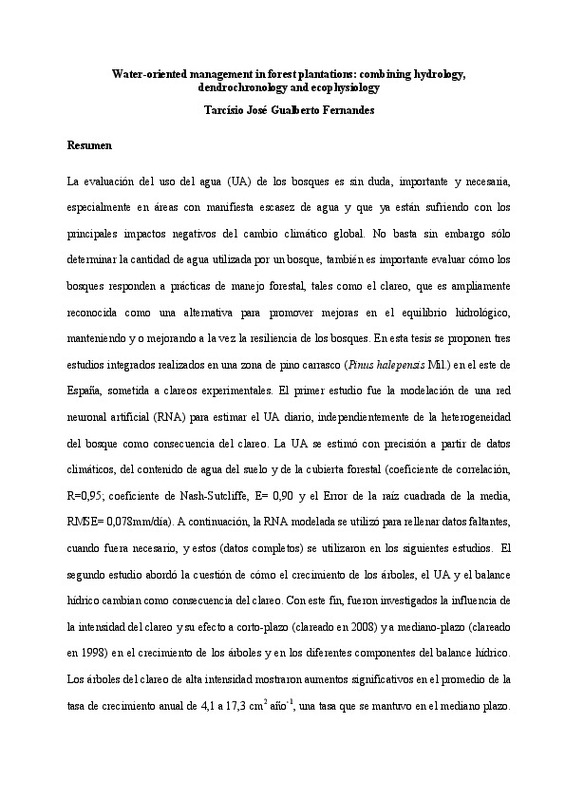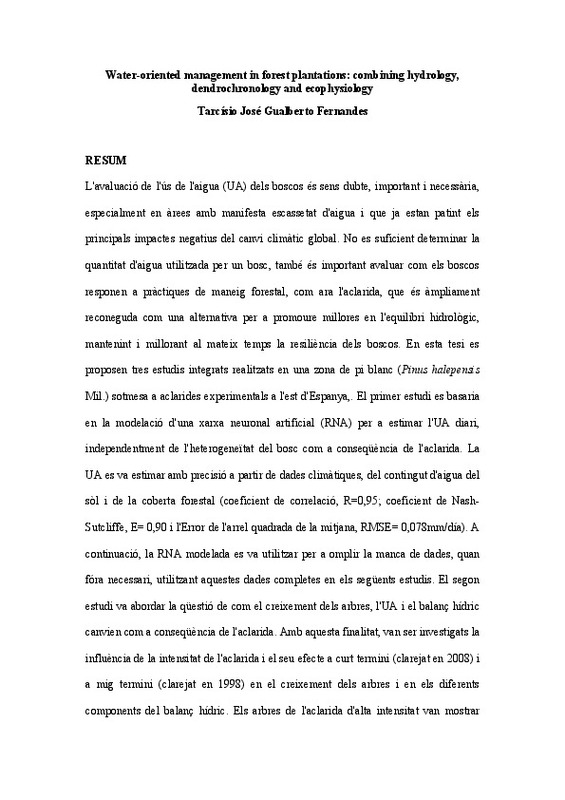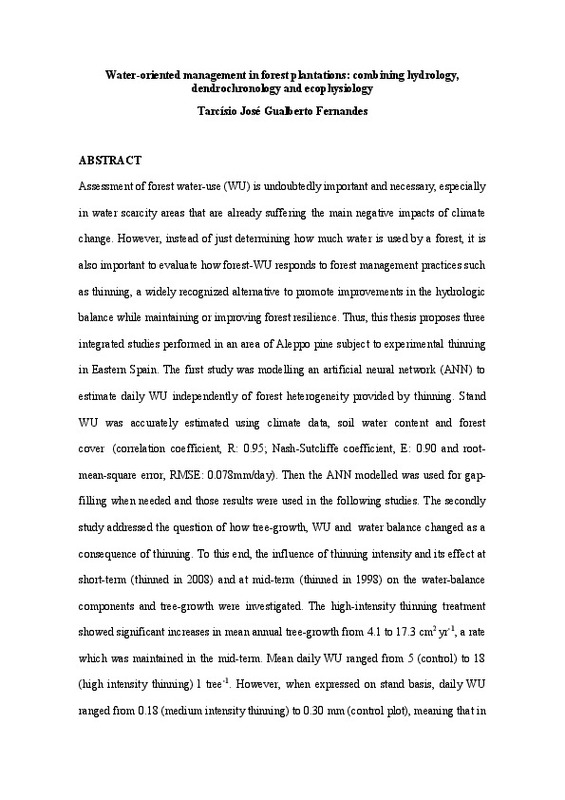- RiuNet repositorio UPV
- :
- Investigación
- :
- Tesis doctorales
- :
- Ver ítem
JavaScript is disabled for your browser. Some features of this site may not work without it.
Buscar en RiuNet
Listar
Mi cuenta
Estadísticas
Ayuda RiuNet
Admin. UPV
Water-oriented management in forest plantations: combining hydrology, dendrochronology and ecophysiology
Mostrar el registro sencillo del ítem
Ficheros en el ítem
| dc.contributor.advisor | Campo García, Antonio Dámaso del
|
es_ES |
| dc.contributor.author | Gualberto Fernandes, Tarcisio Jose
|
es_ES |
| dc.date.accessioned | 2015-03-30T11:15:46Z | |
| dc.date.available | 2015-03-30T11:15:46Z | |
| dc.date.created | 2014-12-09 | es_ES |
| dc.date.issued | 2015-12-09 | es_ES |
| dc.identifier.uri | http://hdl.handle.net/10251/48476 | |
| dc.description | Tesis por compendio | es_ES |
| dc.description.abstract | Assessment of forest water-use (WU) is undoubtedly important and necessary, especially in water scarcity areas that are already suffering the main negative impacts of climate change. However, instead of just determining how much water is used by a forest, it is also important to evaluate how forest-WU responds to forest management practices such as thinning, a widely recognized alternative to promote improvements in the hydrologic balance while maintaining or improving forest resilience. Thus, this thesis proposes three integrated studies performed in an area of Aleppo pine subject to experimental thinning in Eastern Spain. The first study was modelling an artificial neural network (ANN) to estimate daily WU independently of forest heterogeneity provided by thinning. Stand WU was accurately estimated using climate data, soil water content and forest cover (correlation coefficient, R: 0.95; Nash-Sutcliffe coefficient, E: 0.90 and rootmean-square error, RMSE: 0.078mm/day). Then the ANN modelled was used for gapfilling when needed and those results were used in the following studies. The secondly study addressed the question of how tree-growth, WU and water balance changed as a consequence of thinning. To this end, the influence of thinning intensity and its effect at short-term (thinned in 2008) and at mid-term (thinned in 1998) on the water-balance components and tree-growth were investigated. The high-intensity thinning treatment showed significant increases in mean annual tree-growth from 4.1 to 17.3 cm2 yr -1 , a rate which was maintained in the mid-term. Mean daily WU ranged from 5 (control) to 18 (high intensity thinning) l tree-1 . However, when expressed on stand basis, daily WU ranged from 0.18 (medium intensity thinning) to 0.30 mm (control plot), meaning that in spite of the higher WU rates in the remaining trees, stand WU was reduced with thinning. Large differences were found in the water balance components between thinning plots and control. These differences might have significant implications to maintain forest resilience, and improve forest management practices. The third study, brings forth two interesting points and their responses to thinning, WU and intrinsic water-use efficiency (WUEi). First, the relationships between growth and climate were studied at mid-term in order to identify if thinning can improve forest resilience. Second, the relationships between WU and WUEi was explored to identify how these factors were affected by thinning at short-term. A substantial limitation of tree-growth imposed by climatic conditions was observed, although thinning changed the tree-growth-precipitation relationships. Significant differences in WUEi were found after thinning at mid-term, however no significant difference was observed at short-term. Despite this, in general WUEi decreased when precipitation increased, with different slopes for each thinning intensity. Different patterns of the relationship between WU and WUEi were found, being positive for thinned plots and negative for control plot at short-term. Finally this thesis suggest that thinning in Aleppo pine plantations is effective in changing the relationships between WU and WUEi, furthermore, this thesis introduces a novel contribution by looking at the inter-related effects on growth, WU, WUEi and water balance in Mediterranean forest subject to thinning. | en_EN |
| dc.language | Inglés | es_ES |
| dc.publisher | Universitat Politècnica de València | es_ES |
| dc.rights | Reserva de todos los derechos | es_ES |
| dc.subject | Adaptive Forest Management | es_ES |
| dc.subject | Artificial Neural Network | es_ES |
| dc.subject | Forest hydrology | es_ES |
| dc.subject | Hydrology-oriented Silviculture | es_ES |
| dc.subject | Pinus halepensis Mill. | es_ES |
| dc.subject | Tree tranpiration | es_ES |
| dc.subject | Water-use | es_ES |
| dc.subject | Water-use Efficiency | es_ES |
| dc.subject.classification | INGENIERIA HIDRAULICA | es_ES |
| dc.subject.classification | TECNOLOGIA DEL MEDIO AMBIENTE | es_ES |
| dc.title | Water-oriented management in forest plantations: combining hydrology, dendrochronology and ecophysiology | es_ES |
| dc.type | Tesis doctoral | es_ES |
| dc.identifier.doi | 10.4995/Thesis/10251/48476 | es_ES |
| dc.rights.accessRights | Abierto | es_ES |
| dc.contributor.affiliation | Universitat Politècnica de València. Departamento de Ingeniería Hidráulica y Medio Ambiente - Departament d'Enginyeria Hidràulica i Medi Ambient | es_ES |
| dc.description.bibliographicCitation | Gualberto Fernandes, TJ. (2014). Water-oriented management in forest plantations: combining hydrology, dendrochronology and ecophysiology [Tesis doctoral]. Universitat Politècnica de València. https://doi.org/10.4995/Thesis/10251/48476 | es_ES |
| dc.description.accrualMethod | TESIS | es_ES |
| dc.type.version | info:eu-repo/semantics/acceptedVersion | es_ES |
| dc.relation.pasarela | TESIS\6487 | es_ES |
| dc.description.compendio | Compendio | es_ES |
Este ítem aparece en la(s) siguiente(s) colección(ones)
-
Tesis doctorales [5389]






